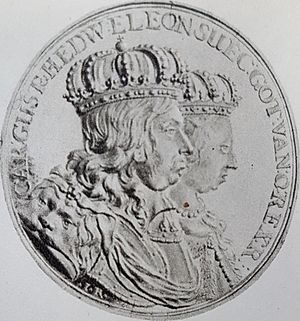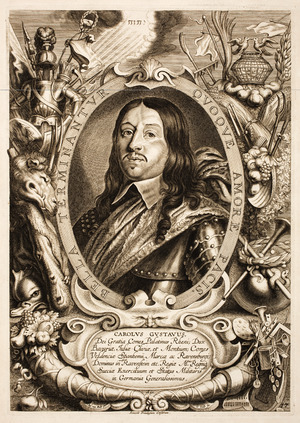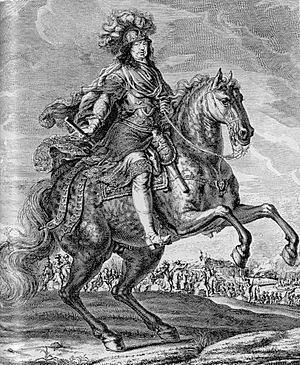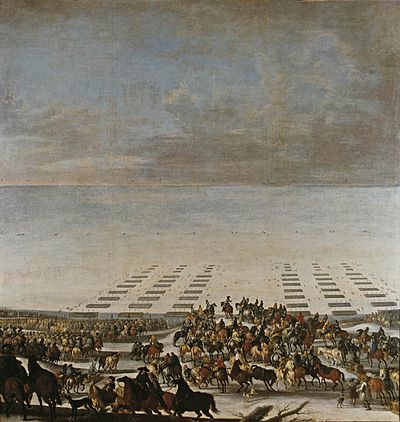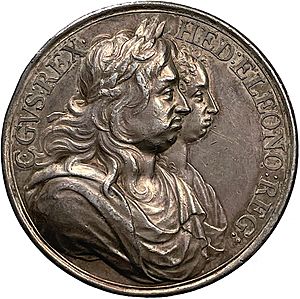Charles X Gustav of Sweden facts for kids
Quick facts for kids Charles X Gustav |
|
|---|---|
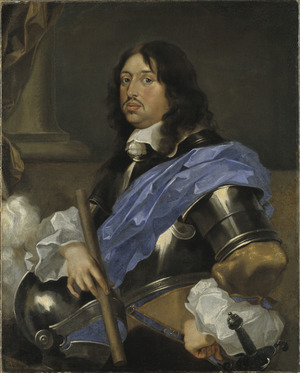
Karl X Gustav by Sébastien Bourdon
|
|
| King of Sweden Duke of Bremen and Verden |
|
| Reign | 6 June 1654 – 13 February 1660 |
| Predecessor | Christina |
| Successor | Charles XI |
| Born | 8 November 1622 Nyköping Castle, Sweden |
| Died | 13 February 1660 (aged 37) Gothenburg, Sweden |
| Burial | 4 November 1660 Riddarholmen Church |
| Spouse | |
| Issue | Charles XI Gustaf Carlson, Count of Börringe and Lindholm (ill.) |
| House | Palatinate-Zweibrücken |
| Father | John Casimir, Count Palatine of Zweibrücken-Kleeburg |
| Mother | Catherine of Sweden |
| Religion | Lutheran |
| Signature | |
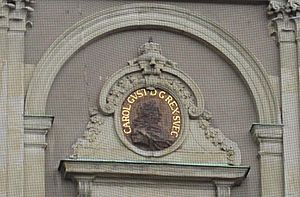
Charles X Gustav (born 8 November 1622, died 13 February 1660) was the King of Sweden from 1654 until his death. He was also known as Carl Gustav. He was the son of John Casimir and Catherine of Sweden.
Charles X Gustav married Hedwig Eleonora of Holstein-Gottorp. They had one son, Charles XI, who became king after him. Charles X Gustav was an important leader during the Second Northern War. This war helped Sweden become a larger empire. He was the first king of the Swedish Caroline era. This period was very important for Sweden's history.
His title, Charles X, comes from an old tradition. A Swedish king named Charles IX (who ruled from 1604–1611) chose his number based on a made-up history of Sweden. Charles X Gustav was actually the fifth King Charles, but he kept the "X" (ten) in his name.
Contents
Becoming King of Sweden
In his early years, Charles X Gustav grew up at the Swedish court. He was raised with his cousin, Queen Christina. He received a very good education. He also learned how to be a military leader. He fought in important battles like the Battle of Breitenfeld (1642) and Jankowitz in the 1640s.
Queen Christina considered marrying him, but she decided not to marry anyone. Instead, in 1649, she declared him her successor. This meant he would become king after her. Some powerful people, like Axel Oxenstierna, did not agree with this choice.
In 1648, Charles became the commander of the Swedish forces in Germany. He also learned a lot about diplomacy. This is the skill of managing relationships between countries. He became very good at it. When Queen Christina decided to give up her throne on 5 June 1654, Charles X Gustav became the new King of Sweden.
Early Days as King
Charles X Gustav was crowned king on 7 June 1654. This was just one day after Queen Christina stepped down. As king, he focused on uniting the country. He also wanted to prepare Sweden for new conquests.
He married Hedwig Eleonora of Holstein-Gottorp on 24 October 1654. This marriage was important for political reasons. He hoped it would help Sweden gain an ally against Denmark.
In March 1655, a special meeting called the Riksdag was held in Stockholm. The king convinced the leaders that a war against Poland was necessary. He believed it would be good for Sweden.
The Second Northern War (1655–1660)
Charles X Gustav led Sweden into a major conflict. This war is known as the Second Northern War (1655–1660).
Fighting in Poland-Lithuania
On 10 July 1655, Charles X left Sweden to fight against the Polish–Lithuanian Commonwealth. He had a large army of 50,000 soldiers and 50 warships. The war had already started with Swedish troops taking over Dünaburg on 1 July 1655.
On 21 July 1655, the Swedish army entered Poland. They quickly took over many areas. The Polish king, John II Casimir of Poland, had to flee. Many Polish nobles and their armies joined the Swedes. They saw Charles X Gustav as a strong leader.
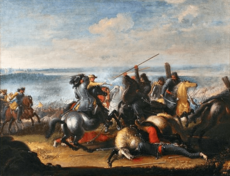
Charles X Gustav continued his advance and captured Kraków. However, the Polish people soon began to fight back. On 18 November 1655, the Swedes tried to capture the Częstochowa monastery. But the Poles defended it bravely. After 70 days, the Swedes had to retreat. This victory made the Polish people feel very proud. They started to see Charles X Gustav as a harsh invader.
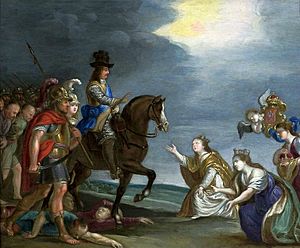
In early 1656, King John II Casimir returned to Poland. His army had grown stronger. Charles realized it was easier to defeat Polish armies than to fully control Poland. He also faced a new enemy: the elector of Brandenburg, Frederick William I. Charles forced Frederick William to become his ally.
Charles then had to deal with Polish fighters using guerrilla tactics. He lost many soldiers without clear results. Meanwhile, Russia made peace with Poland. They then attacked Sweden's territory in Livonia, laying siege to Riga.
Charles's retreat from Jarosław to Warsaw was very difficult. His army was trapped by Polish-Lithuanian forces. But he managed to escape, which was seen as a brilliant military move. On 21 June 1656, the Poles recaptured Warsaw. Charles had to make a new deal with Frederick William I. On 28–30 July, the combined Swedish and Brandenburg armies defeated John Casimir's army at Warsaw. However, the Polish forces retreated without heavy losses. The Swedes reoccupied Warsaw, causing much damage.
Charles then made another alliance with the elector of Brandenburg. This deal gave Frederick William full control of East Prussia.
War Against Denmark-Norway
Charles X Gustav was happy when Denmark-Norway declared war on Sweden on 1 June 1657. He knew that Denmark was weak if attacked from the south. He quickly moved his army into Holstein. The Danish army scattered, and the Swedes took over the duchy of Bremen.
By early autumn, Swedish troops were all over Jutland. But the fortress of Fredriksodde held them back for two months. Also, the Danish-Norwegian fleet stopped the Swedish fleet from attacking the Danish islands.
The situation became difficult for Charles. Denmark-Norway and Poland-Lithuania formed an alliance against Sweden. The elector of Brandenburg also joined them. Charles had to consider peace talks. However, he got a boost when Fredriksodde was captured. He then planned to move his troops to the island of Funen.
Crossing the Belts
In December 1657, a very cold winter began. The sea started to freeze. Charles X Gustav saw an opportunity. On 28 January 1658, he arrived in South Jutland. His experts believed the ice on the Small Belt would soon be strong enough for his army to cross.
On the morning of 30 January, the king ordered his army to cross the frozen Small Belt. Horsemen got off their horses on weaker ice spots. They carefully led their horses. Then they got back on and charged for the shore. The Swedish army quickly took over Funen. They lost only two cavalry companies, which fell through the ice.
Charles X Gustav then decided to cross the frozen Great Belt to reach Copenhagen. His chief engineer, Erik Dahlberg, suggested a longer but safer route. This route went across the islands of Langeland, Lolland, and Falster.
On the night of 5 February, the army began its crossing. The cavalry led the way through the snow-covered ice. The infantry followed, wading through slush. They risked the ice breaking. But by three in the afternoon, the army reached Lolland without losing a single soldier. On 8 February, Charles reached Falster. By 11 February, he was safely on the island of Zealand. This was an amazing military feat.
This incredible crossing forced Denmark-Norway to sign the Treaty of Roskilde on 26 February 1658. Denmark had to give up a large part of its land to Sweden. However, Charles X Gustav decided to continue the war against Denmark. On 17 July, he landed on Zealand again and besieged Copenhagen. But the city held out. The Dutch fleet arrived and defeated the Swedish fleet in the Battle of the Sound on 29 October 1658. Copenhagen also successfully defended against a major Swedish attack.
Meeting in Gothenburg
Charles X Gustav agreed to talk about peace with Denmark. At the same time, he planned a winter attack on Norway. This required more money from his people, who were already struggling. In December 1659, he went to Sweden to meet with the estates in Gothenburg. The common people did not want more taxes. But Charles managed to convince them.
Illness and Death

Soon after the meeting started on 4 January 1660, Charles X Gustav became ill. He had symptoms of a cold. He ignored his illness and kept inspecting his troops near Gothenburg. He soon became very sick with chills, headaches, and trouble breathing.
On 15 January, his doctor arrived. The doctor mistakenly thought Charles had a different illness. He gave Charles many treatments that did not help. After three weeks, Charles's fever went down, but his lung infection got worse. By 8 February, he had a serious blood infection.
On 12 February, Charles X Gustav signed his will. His son, Charles XI of Sweden, was still a child. So Charles X Gustav named a group of relatives and friends to rule until his son was old enough. Charles X Gustav died the next day, on 13 February 1660, at the age of 37.
Family
Charles X Gustav had one official child with his wife, Hedwig Eleonora of Holstein-Gottorp. This was his successor, Charles XI (1655–1697).
Before his marriage, Charles X Gustav had a son named Gustaf Carlson (1647–1708) with his mistress, Märta Allertz. Gustaf Carlson later became a Count.
There are also theories that Charles Gustav had other children before his marriage.
Images for kids
-
Karl X Gustav by Sébastien Bourdon
See also
 In Spanish: Carlos X Gustavo de Suecia para niños
In Spanish: Carlos X Gustavo de Suecia para niños


